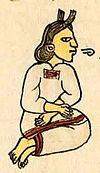Portal:Indigenous peoples of the Americas
Discover Wikipedia using portals
Portal maintenance status: (June 2018)
|
The Indigenous peoples of the Americas PortalCurrent distribution of Indigenous peoples of the Americas The Indigenous peoples of the Americas are groups of people native to a specific region that inhabited the Americas before the arrival of European settlers in the 15th century and the ethnic groups who continue to identify themselves with those peoples. The Indigenous peoples of the Americas are diverse; some Indigenous peoples were historically hunter-gatherers, while others traditionally practice agriculture and aquaculture. In some regions, Indigenous peoples created pre-contact monumental architecture, large-scale organized cities, city-states, chiefdoms, states, kingdoms, republics, confederacies and empires. These societies had varying degrees of knowledge of engineering, architecture, mathematics, astronomy, writing, physics, medicine, planting and irrigation, geology, mining, metallurgy, sculpture and gold smithing. (Full article...) Selected article Nahuatl (/ˈnɑːwɑːtəl/; Nahuatl pronunciation: [ˈnaːwatɬ] ⓘ), known informally as Aztec, is a language or group of languages of the Uto-Aztecan language family. Varieties of Nahuatl are spoken by an estimated 1.5 million Nahua people, most of whom live in Central Mexico. All Nahuan languages are indigenous to Mesoamerica. Nahuatl has been spoken in Central Mexico since at least the 7th century AD. It was the language of the Aztecs who dominated what is now central Mexico during the Late Postclassic period of Mesoamerican history. During the centuries preceding the Spanish conquest of Mexico, the Aztec Empire had expanded to incorporate a large part of central Mexico, and its influence caused the variety of Nahuatl spoken by the residents of Tenochtitlan to become a prestige language in Mesoamerica. At the conquest, with the introduction of the Latin alphabet, Nahuatl also became a literary language, and many chronicles, grammars, works of poetry, administrative documents and codices were written in it during the 16th and 17th centuries. This early literary language based on the Tenochtitlan variety has been labeled Classical Nahuatl and is among the most studied and best-documented languages of the Americas. Selected image Chapito, a Seri shaman from Punta Chueca, Sonora, Mexico. Chapito requested to be photographed pointing toward the mountain caves. image credit:Tomás Castelazo
General imagesThe following are images from various Indigenous peoples of the Americas-related articles on Wikipedia.
Selected biographyCrazy Horse (Lakota: Tȟašúŋke Witkó in Standard Lakota Orthography, IPA:tχaʃʊ̃kɛ witkɔ), literally "His-Horse-Is-Crazy"; ca. 1840 – September 5, 1877) was a Native American war leader of the Oglala Lakota. He took up arms against the U.S. Federal government to fight against encroachments on the territories and way of life of the Lakota people, including leading a war party to victory at the Battle of the Little Bighorn in June 1876. Four months after surrendering to U.S. troops under General Crook in May 1877, Crazy Horse was fatally wounded by a military guard, using his bayonet, while allegedly resisting imprisonment at Camp Robinson in present-day Nebraska. He ranks among the most notable and iconic of Native American tribal members and has been honored by the U.S. Postal Service with a 13¢ Great Americans series postage stamp. Did you know…
SubcategoriesRelated portalsThings you can do
Selected panoramaTopics
Recognized content
Featured articlesFormer featured articlesGood articles
Former good articlesDid you know? articles
In the News articlesAssociated WikimediaThe following Wikimedia Foundation sister projects provide more on this subject:
American indigenous language WikipediasAvañe'ẽ (Warani) · Aymar aru (Aymara) · ᏣᎳᎩ (Cherokee) · Chahta (Choctaw) · ᐃᔨᔫ (Cree) · ᐃᓄᒃ (Inuktitut) · Iñupiak · Kalaallisut (Greenlandic Inuit) · Mvskoke (Muscogee) · Nahuatlahtolli · Diné bizaad (Navajo) · Qhichwa Simi · Tsêhesenêstsestôtse (Cheyenne) Indigenous languages in Wikimedia Incubators: Alabama · Blackfoot · Chinook Jargon · Choctaw · Creek · Lakota · Micmac · Mohawk · Nheengatu · Northwestern Ojibwa · O'odham · Shoshoni · Unami-Lenape · Wüne pakina (Mapudungun) · Yucatec Maya · Central Alaskan Yup'ik · Zuni | |||||||||||||||||||||||||||||||||||||



